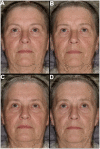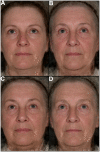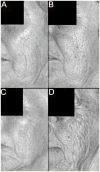Why some women look young for their age
- PMID: 19956599
- PMCID: PMC2779449
- DOI: 10.1371/journal.pone.0008021
Why some women look young for their age
Abstract
The desire of many to look young for their age has led to the establishment of a large cosmetics industry. However, the features of appearance that primarily determine how old women look for their age and whether genetic or environmental factors predominately influence such features are largely unknown. We studied the facial appearance of 102 pairs of female Danish twins aged 59 to 81 as well as 162 British females aged 45 to 75. Skin wrinkling, hair graying and lip height were significantly and independently associated with how old the women looked for their age. The appearance of facial sun-damage was also found to be significantly correlated to how old women look for their age and was primarily due to its commonality with the appearance of skin wrinkles. There was also considerable variation in the perceived age data that was unaccounted for. Composite facial images created from women who looked young or old for their age indicated that the structure of subcutaneous tissue was partly responsible. Heritability analyses of the appearance features revealed that perceived age, pigmented age spots, skin wrinkles and the appearance of sun-damage were influenced more or less equally by genetic and environmental factors. Hair graying, recession of hair from the forehead and lip height were influenced mainly by genetic factors whereas environmental factors influenced hair thinning. These findings indicate that women who look young for their age have large lips, avoid sun-exposure and possess genetic factors that protect against the development of gray hair and skin wrinkles. The findings also demonstrate that perceived age is a better biomarker of skin, hair and facial aging than chronological age.
Conflict of interest statement
Figures



References
-
- Perrett DI, Lee KJ, Penton-Voak I, Rowland D, Yoshikawa S, et al. Effects of sexual dimorphism on facial attractiveness. Nature. 1998;394:884–887. - PubMed
-
- Dixson AF, Halliwell G, East R, Wignarajah P, Anderson MJ. Masculine somatotype and hirsuteness as determinants of sexual attractiveness to women. Arch of Sexual Behavior. 2003;32:29–39. - PubMed
-
- Christensen K, Iachina M, Rexbye H, Tomassini C, Frederiksen H, et al. “Looking old for your age”: Genetics and mortality. Epidemiology. 2004;15:251–252. - PubMed
-
- Borkan GA, Norris AH. Assessment of Biological Age Using A Profile of Physical Parameters. J Gerontol. 1980;35:177–184. - PubMed
Publication types
MeSH terms
Substances
Grants and funding
LinkOut - more resources
Full Text Sources
Medical

